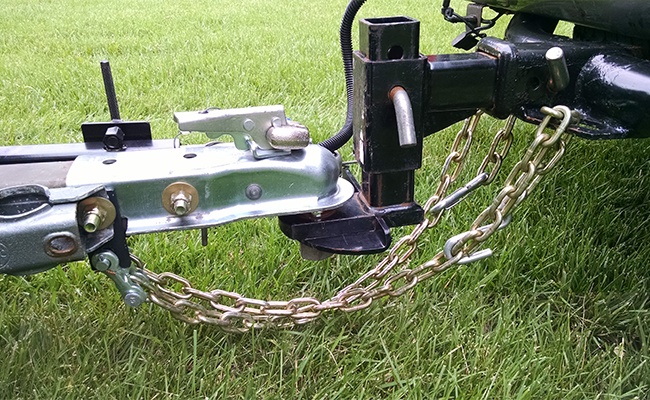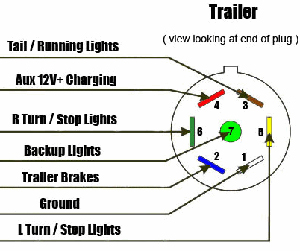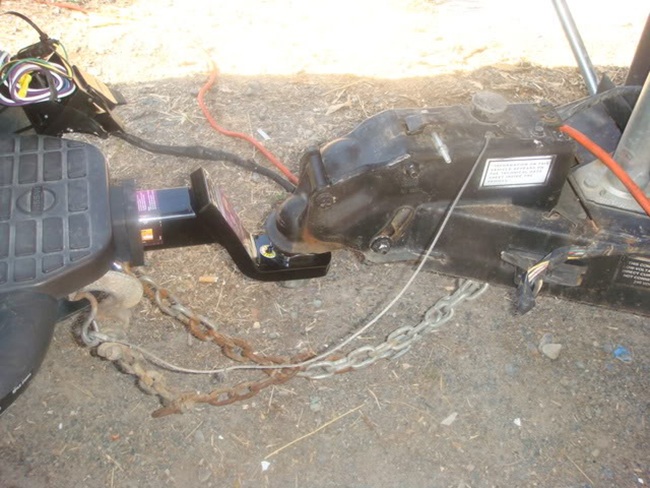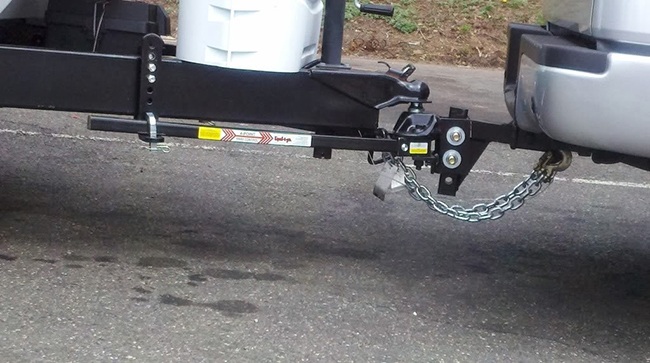We began last week by talking about a recent occurrence wherein a new tiny house owner was towing her tiny house down the Interstate with a half-ton pickup truck. Upon switching lanes on a less-than-desirable road, she lost control and the house went down on its side. She was kind enough to post photos of the incident, allowing people to ask further questions and comment. It brought to the public attention that towing your tiny house on wheels is not a task to be taken lightly. The initial post stopped on weighing your tongue as a step towards safe towing. This week we pick up on actually connecting the trailer to the towing vehicle.

CHECK YOUR COUPLER
If your tiny house on wheels trailer is in proper working order it will have a locking mechanism or latch on it to prevent it from becoming detached while in use. When you drop your trailer onto the hitch ball it will snap forward allowing you to know the trailer is locked down into the ball. Be aware that in order for this to work properly the latch mechanism will need to be disengaged prior to sliding the coupler over the hitch ball. Once in place, a hitch pin or lock should be used to keep the coupler latch in the locked position.
ENGAGE YOUR SAFETY CHAINS
A trailer suitable for towing will have chains attached to either side of the trailer receiver. This attachment is usually secured by a weld or an anchor shackle. The chains should then be crossed before hooking onto the hitch. This creates a cradle in case the trailer jumps the ball. The chains will catch the trailer and allow you to safely come to a complete stop. If the chains are long enough that they make contact with the ground after being attached, they can be twisted together to remove the initial slack. You do not want them to drag the ground and create sparks as you travel. Now, this step can be confusing because if you are using a full weight distribution kit complete with spring bars, then the chains will go from the receiver to a hook on the spring bars. This will require a lift lock which will serve to tighten the slack in the chains and allow the spring bars to firm up the connection between the tow vehicle and the trailer. (see image)

CONNECT YOUR WIRES
 Most pickup trucks with a tow package, manufactured after 2012, come equipped with a plug receiver, both 4-pin and 7-pin. This ensures that you can tow a lightweight, utility trailer, and a larger trailer. Whatever the case, your tow vehicle will need to have a compatible plug insert. The 7-pin plug is a round 2″ diameter connector that allows an additional pin for an auxiliary 12-volt power or backup lights.
Most pickup trucks with a tow package, manufactured after 2012, come equipped with a plug receiver, both 4-pin and 7-pin. This ensures that you can tow a lightweight, utility trailer, and a larger trailer. Whatever the case, your tow vehicle will need to have a compatible plug insert. The 7-pin plug is a round 2″ diameter connector that allows an additional pin for an auxiliary 12-volt power or backup lights.
BREAKAWAY
One of the most essential parts of a tiny house on wheels trailer is the electric brakes with breakaway kit. Breakaway kits are designed to bring trailers safely to a stop by activating the electric brakes should a trailer disconnect from the tow vehicle during transit. Ideally, the safety chains will prevent a trailer from disconnecting if the coupler comes off the ball. However, if the safety chains fail, the breakaway kit acts as a last line of defense against a runaway trailer. This type of safety system is required in most states for trailers weighing more than 3,000 lbs.1 The device engages the electric brakes of the trailer. A non-powered wire is attached from the trailer to the tow vehicle, which is connected to a physical switch. In more simpler terms, if the trailer disconnects, the cable pulls a pin out of the switch, activating the trailer brakes.

CHECK THE BATTERY
The brake controller includes a battery that is used to engage the electric brakes should an emergency occur. The battery is charged through the 7-pin adaptor each time the trailer is hooked up to a tow vehicle. Once you are hooked up, press the TEST button to make sure the battery is functioning properly.
ATTACH THE REMAINING PIECES
In most weight distribution kits, there are a few more pieces that will ensure a smooth drive for you. The first is the spring bars (NOTE: these can be in the form of round bars or trunnion bars) which run from the head assembly to a pair of chains. In this setup, the chains hang down below the trailer from a set of brackets and attach to them in a way that creates tension along the spring bars. As the tongue weight pushes the bars down, the chains pull the bars up. In order to straighten out to their natural positions, the spring bars push up on the head assembly, distributing the weight among the axles.2

PREPARE FOR SWAY
Trailer sway can be caused by crosswinds, lack of weight distribution, inadequate spring bar tension, a loose trailer ball, and a number of other things. Using a weight-distributing hitch by itself may help limit trailer sway by evenly distributing the weight of the load, but it will do little to improve sway caused by mother nature. This is where your anti-sway bar comes into play. It is important to know that trailer sway devices come in 2 types: those that reduce sway once it has begun and those that work to prevent sway altogether. Using a 2-point anti-sway bar (the most simple of options) serves the purpose of forcing your trailer through friction to stay straight. It helps to eliminate any plan between your tow vehicle and your trailer.
Here is a very short video to illustrate how to attach an anti-sway bar.
Once all of those systems are in place you should feel confident getting into the driver’s seat knowing your trailer has been properly prepared for the open road. Once you start down the road stop at about 50 miles and then again at 100 miles to ensure everything is still tight and in place. A trailer with a properly distributed load will drive good and feel solid. If you do experience sway, it is likely because your weight is not distributed well. You can never be too careful when towing your tiny house on wheels!
You can find other great towing resources on sites like eTrailer, Camping World, Tiny House Giant Journey, Tiny House Builders, Tiny r(E)volution, and many others! Search and ye shall find.
1 https://www.etrailer.com/faq-trailer-breakaway-kit-installation.aspx
2 http://auto.howstuffworks.com/auto-parts/towing/equipment/hitches/towing-weight-distribution-systems3.htm
Feature photo: 30′ tiny house on wheels by Rocky Mountain Tiny Houses
By Andrew M. Odom for the [Tiny House Blog]

That’s a good idea to make sure that you have chains connecting to the truck as well. I would think that if the coupler broke for any reason, that would prevent the house form hitting something. I’ll have to remember to get some of those, as well as making sure that everything is properly connected so I could be safe while towing.
Thanks for the great story! As you mention in the end of the article it is very important to stop after 50 and 100 miles to ensure everything is still tight and in place. Please note it wouldn’t hurt to be extra cautious and stop again every 50-100 miles. In particular if this is the first time towing your tiny house, I would advise that. Also if you are driving on bad roads with lots of potholes, you have to be extra cautious.
Thank you for the great tips! This seems like it could be very dangerous if not done properly! Thanks for sharing.